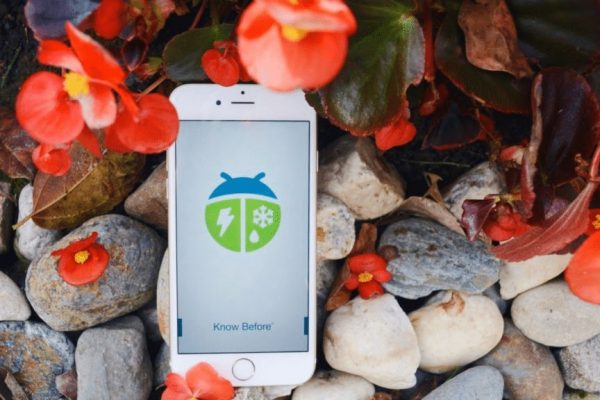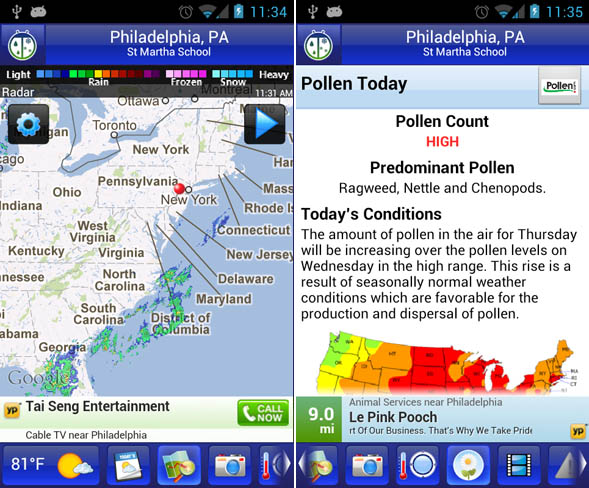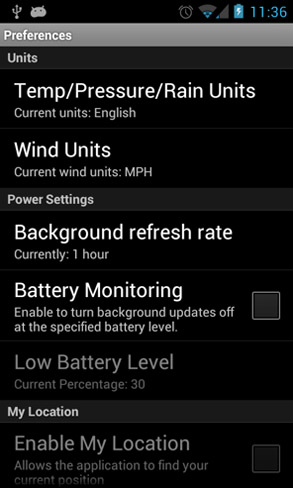With so many different apps available on your smartphone today, it is easier than ever to stay on top of everything important to you. Interested in sports? You can download sports-related apps. How about entertainment? There are social media and video streaming apps. And if you want to stay updated with the weather, then the WeatherBug app is for you.
What Is WeatherBug

One of the best weather apps ever created is WeatherBug. You might have experienced this kind of app before, but others probably just give you an overview of what the weather would be like and nothing more. However, with WeatherBug, you can get more than just an overview and see how the weather will affect your daily life.
WeatherBug is the most accurate weather app in the market that provides lightning alerts along with other weather information. Because of the uncertain changes in the weather pattern for the past few years, most people care about the day-to-day weather forecast. If there are any unexpected changes in the weather, your plans may be ruined or bring danger. Thankfully, you can be updated with the weather forecast with WeatherBug.
One reason why WeatherBug is one of the best apps is that it came from a trusted source. There are many apps available on the Google Play Store or the App Store to date, so you must choose the most reliable one. In the case of WeatherBug, the app has been downloaded more than 10 million times, and it is completely free to download and install. If keeping track of weather is important for you, then go ahead and download this most trusted app.
History & Development
When WeatherBug was first launched in 1993, the brand was under Automated Weather Source. Founded by Bob Marshall and a few partners, the brand was initially pushed as a provider of weather tracking stations, the data from which is generated on their website. The brand was also marketed as educational software available to public and private schools. After a couple of years, the company partnered with different TV stations by providing their collected data for TV weather reports.
The WeatherBug desktop application and the website was first introduced in 2000 and was later launched as smartphone apps on Android and iOS as WeatherBug and WeatherBug Elite. 2004 was a big year for the company, as WeatherBug finally got the certification to display the TRUSTe privacy seal on their website.
In 2005, WeatherBug was flagged as a low-risk threat by Microsoft SpyWare. However, the company argued that its desktop application is not a form of spyware. They also said that WeatherBug is incapable of tracking the users’ overall web use or getting any data from their hard drive.
The founding company later changed its name to AWS Convergent Technologies Inc. and later to what we know as Earth Networks, Inc. WeatherBug was the most popular weather information service on the internet, with weather app giants such as The Weather Channel and other sites run by Weather Underground and Accuweather running behind it.
In 2013, the WeatherBug app won an APPY app design award making it one of the best in the market during that time till now. Apart from the smartphone app, WeatherBug also offers a lighting tracking safety system that is currently used in Southern Florida and other parts of the United States.
Just this 2016, the brand was acquired by xAd from Earth Networks.
Features of WeatherBug

Lifestyle
Lifestyle is one of the most favorite widgets because it tells users how the weather will impact their favorite routine. Do you want to clean up the yard? The app will provide you with an ideal timeframe to do it. Do you want to know when your allergies will be at their peak? You can find the answer here. This widget will enable you to take the data provided and apply it to your daily life.
Home Energy Usage
This is another powerful feature of WeatherBug. If you want to save money on your utility bills and conserve energy, then you can use this app to help you save a couple of bucks. Based on the weather in your area, the app allows you to sync up your home’s thermostat and find out the ideal temperature range for your home.
This is the best feature that sets the app apart from its competition. This feature provides an estimated amount of energy to keep your house in a comfortable condition by estimating the HVAC system energy usage in an average house. The WeatherBug app also allows you to find out how much energy can be saved by adjusting the thermostat, making this app green and economical. There’s no other weather app out there that can help you save money and energy at the same time.
Weekly Outlook
Another valuable feature of the app is the weekly outlook. It enables you to get an overview of what the weather of the week would look like. This option allows you to get a comprehensive view of the coming days, rather than just a list of highs and lows. You can also find here what expert meteorologists have to say about the weather on any given week.
Track Any Condition
With the WeatherBug app, you can track any condition, plus these other features:
- Alerts for severe weather conditions
- Up-to-date weather forecast of your current location and other areas
- Comprehensive details of hourly and ten-day weather forecasts
- Local and national pollen counts and data
- Precipitation data through live Doppler radar
- Notification alerts of the current weather status on your smartphone
- Precise weather details such as wind speed, UV index, weather observation and many more
- Option to track hurricane forecast using the satellite and radar
- Ten days of snow forecast and real snowstorm alerts for severe winter climate
Other Features
Other notable features of the WeatherBug app are saving multiple locations, customizable settings including a temperature readout in your status bar, and interactive maps so you can see what the weather looks like around you visually, rather than just numbers.

When it comes to performance, WeatherBug is surprisingly good. Most weather apps run too slow on an outdated smartphone but surprisingly, WeatherBug runs smooth and crisp on such devices, and without hiccups. It also provides numerous features that are functional for different situations, such as radar maps and pollen counts. The former is perfect for tracking weather patterns, while the latter helps in battling allergies.
WeatherBug has some other settings and available preferences apart from what was mentioned. Some of the usual features are setting the frequency of weather updates, changing units of measurement, etc. It also has Battery Monitoring, which automatically turns off background weather updates when your smartphone is low on battery.
WeatherBug Subscription Options
Free
We know that everybody loves a free weather app. Not only is WeatherBug free, but it also has a free widget available. The fun features include planning out your day, gardening forecast, and even alerts of which fruit or vegetable is currently in season. The free version has a small ad banner at the bottom of the screen.
Premium
The changes happening in our climates may have a negative impact on our lifestyle. That’s why WeatherBug has introduced a new premium feature called Lifestyle Forecast. This new premium feature is perfect for those who want to know the current weather in relation to an outdoor event, allergies, workouts, any chronic pain, and a whole lot more. This feature is not available on any other traditional kind of weather apps.
This premium version is called WeatherBug Elite, which costs $1.99. It removes all ads from the application. Additionally, the radar becomes fully-featured with animations, additional map layers, and even cached data for offline viewing.
How to Use WeatherBug
Most people only know about the two commonly used legitimate weather sources: The Weather Channel and AccuWeather. Both of these apps are available on iOS and Android devices and provide information about the weather. But the WeatherBug app is something that a lot of people have been raving about and is the must-have one.
Even though some people may have heard the WeatherBug name for the first time, it has been around for a couple of years now and was firstly available on desktop PC. It used to have a negative image around the site because of all the popups and annoying messages making some people think of it as spyware, but Microsoft has debunked this myth.
No need to worry because the app does not bombard you with unwanted apps and would not spy on your data. Here are some of the ways you can use the app:
- Customize the weather information
- Access local weather condition, weather map, and weather radar
- Weather condition is available in multiple languages
- Choose from different temperature units (Fahrenheit and Celsius)
- The wind units are shown in KPH, MPH, Knots, and MPS
- The pressure units are available in inches and millibars.
Current Weather Forecast
Once you open the app, you will see a decently designed start page that highlights all the information needed such as current weather conditions and the forecast for the remainder of the day. Everything is neatly laid out, easy to find, and the page shows everything you want from just a glance of the weather.
Some tabs show hourly and 10-day forecasts that include cloud conditions and high/low for the days. When you click at a particular forecast, you will see a detailed breakdown of the exact conditions. Here you will find a lot of useful information such as the rate of temperature change, the rate of precipitation, humidity, air pressure, wind speeds, and more.
Upcoming Forecast

You can access the upcoming forecast by clicking on the 10-day tab in the app. The layout is clean and will give cloud and temperature data, which is 90% of what you would want to know in the coming days. If you need more information, just click on the individual days and read the description of the forecast weather.
Although, you can’t find a way to view hour-by-hour forecasts, which is something most people need when planning outdoor events. If you want to know the exact wind, temperature, and cloud conditions of a particular day at a particular time, WeatherBug doesn’t have this option yet.
How to Download WeatherBug on iOS
Start using WeatherBug on your Apple device. Simply follow these steps below:
- Go to the App Store.
- Search for “WeatherBug” by typing it in the search bar.
- Select “WeatherBug” from the search result. Open the app page and tap “Install.” This will start the installation process. Once installed, the app can now be visible on your home screen.
How to Download WeatherBug on Android
If you want to start using WeatherBug on your Android phone, just follow these steps below:
- Go to your Google Play store.
- Type “WeatherBug” in the search box and press the magnifying glass in the box.
- Select the app from the search result. Once you’ve opened the app page from the search result, tap the “Install” icon from the screen. This will start the installation process.
- Once installed, you will see the WeatherBug on your home screen and you can start using it.
Pros and Cons of WeatherBug
Pros
- Clean layout and aesthetics
- Easy to navigate
- Smooth, fast, and without lag
- Accurate weather details taken from airports, schools, and weather stations
- Integrates perfectly into any notification bar
- More information available than its competing weather apps
- Video for weather at each weather station
Cons
- iOS home screen is not as robust as the Android version
- Tapping the back button of the phone closes the app instead of going to the previous screen
- Video forecasts are not specific to your location
WeatherBug vs. Other Weather Apps

Compared to the Weather Channel that has a bigger name, WeatherBug is one of the most popular weather apps available on almost every mobile platform. It uses data and real-time images chosen from different monitoring stations at schools and weather stations across the country in addition to the data gathered for the National Weather Service.
Because there are over 35,000 monitoring stations around the globe, WeatherBug can provide hyper-local weather updates, which includes station images, that go beyond the current condition basics to include historical data. So how does this compare to other weather apps?
Interface
The main page of WeatherBug on both Android and iOS devices display the current conditions and the forecast for the day. At the bottom part of each version is a series of icons for Camera, Conditions, Forecast, Maps, and Videos.
The Android version has icons that show pollen count, weather alerts, help, and more in-depth condition information. For some, the additional icons can be bothersome, making the iOS layout a more preferable version, which labels each icon and eliminates some of the guesswork of the Android version.
WeatherBug was the only app on Android that integrated itself into the notification tray if background updates are allowed. The current temperature is always displayed on the top bar and is not annoying to your phone’s overall look.
When you open your notification area, you will see an abbreviated version of the forecast that shows you the current temperature and the expected high or low, depending on the time of day. Tapping the weather icon in the notification tray will bring you directly into the app.
Performance
The app displays the current conditions from the weather station that is closest to your location, any location you put in, or the zip code you’ve manually entered. Apart from the weather data, you can also view a live image of the current conditions at that weather station. This is more of a neat feature rather than a truly useful one, and nice for checking information. Click to enlarge the weather if you work inside the whole day, or if you’ll be traveling and want to see what the actual conditions are like.
WeatherBug and The Weather Channel include video weather forecasts called “Rachel’s Weathercast,” though “Rachel” never anchored during the testing. However, WeatherBug isn’t as local as The Weather Channel’s data.
Both Android and iOS apps gave the same general two-minute forecast. The only difference between the iOS and Android versions is that the Android one uses Google Maps and the iOS version uses Bing. However, neither of the mapping services is better than the other and both have options for rainfall, traffic, and other condition overlays.
Free vs. Premium
The free version of WeatherBug contains ads, while the premium version is ad-free. The premium version also includes full radar animation, additional map layers for infrared satellite, humidity, air pressure, wind’s speed, and the coming days’ high and low. It also has cached weather data for offline viewing, enhanced current conditions, and touch anywhere map for the local forecast.
Use the Weatherbug App Now and Plan Ahead
WeatherBug is currently the best weather app for Android and iOS. It gets all the major points for its clean design and easy-to-use interface. The fact that the app has more features compared to its competitors is just the tip of the iceberg.
Of all the weather apps available, WeatherBug has the greatest amount of information immediately available, which makes it as reliable as the other weather apps. While the video forecasts are not as local as the Weather Channel app, the app’s richness in detail and integration with the notification bar make it a favorite weather app for Android users.
The WeatherBug app is a practical and reliable app to monitor the weather. One of the best features is seeing how the weather can impact your utility bills, your lifestyle, and the traffic. And most of all, it is conveniently customizable for your needs.
If you’re interested to know more about these programs, here is our list of the best Android weather apps that you can try. We also have an in-depth article that talks about AccuWeather. Lastly, if you want to find out more about different mobile programs, you can visit our mobile apps page.
